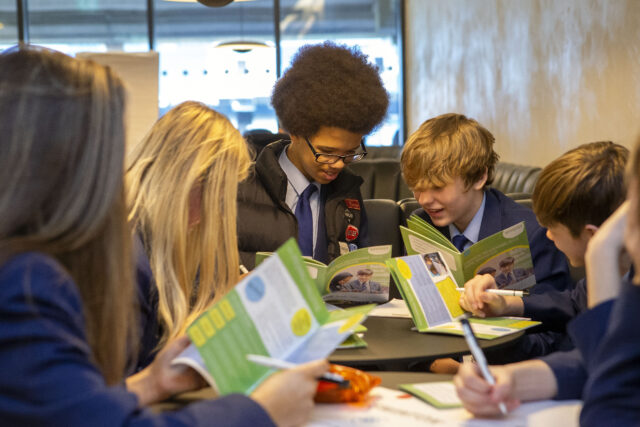How to engage schools in youth social action

Schools are often seen as a great way to engage young people in their local communities. They frequently provide a safe and equitable space to introduce young people to youth social action so they can explore ways to help others without dedicating additional time or resources outside of their school hours.
However, schools are increasingly operating in a challenging landscape with finite resources. With the effects of the pandemic restrictions and cost of living crisis still felt by young people and the schools they attend, engaging with schools on youth social action projects can present challenges to delivery organisations who want to work with them. Schools are faced with difficult choices as they’re forced to prioritise what they work on and who they work with. This can sometimes lead to a focus on the academic progress of their young people and present a barrier to engaging young people in youth social action, and our partners have had to work around this.
Our funding
In 2020 we funded 42 partners to deliver Bereavement Support, Community Spaces and Schools Transitions projects.
In 2022, 30 out of the 42 partners took up the opportunity to continue their work with an additional year’s funding and have been sharing their learning with us throughout their journey.
Between 2020 and 2023 our funded partners supported 13,000 young people to improve the design and use of community spaces, support their peers’ wellbeing in the transition from primary to secondary school and to access safe spaces and share their experiences of bereavement.
Top Tips
Our 17 Schools Transitions projects specifically shared their insights in how they engaged with schools to support young people in their transition from primary to secondary schools. We wanted to share their top tips to help any organisations wanting to run projects with schools in their community.
Relationship Management is key
This can seem like an obvious tip, but our funded partners told us that they needed to build time and capacity for relationship management into their project plans, both before a project starts and during project delivery.
They also found it was important to make connections with the right staff members. Having champions within the school made it easier to carry out project delivery and ensured that the project was delivered regularly, despite competing priorities.
“Having a key member of staff to liaise with means the consistent and steady flow of delivery to the pupils which makes a positive impact.”
One of our funded partners
Funded partners also highlighted the need to ensure there were clear expectations at the beginning of a project, particularly around the commitment the schools needed to make to maintain engagement.
A bespoke approach is important
Our funded partners found that schools have bespoke needs and it was therefore important to adapt their project delivery to meet the needs of each school they worked with. This meant adapting sessions to fit in with the schools’ calendar. Partners identified that they needed to work around exam periods, for example, as they would experience considerable drop off from students who needed to concentrate on their academic work.
For other partners, not having a dedicated space within the school impacted their delivery. Often it was not possible for the delivery staff to have one allocated room which made it difficult for young people to come to them. Partners had to find creative ways to address having to regularly move to different spaces. One partner developed a resource trolly for their project as the school could not provide a dedicated space. This trolly was used by the young people to move resources to whichever room was available for that session.
Build into School plans
In building relationships and developing a bespoke approach, the partners were able to embed the projects within each school’s transition plans. This has helped ensure that the project has a lasting legacy. One project created a sustainability pack to leave with teachers at the end of the project which included resources that the young people involved created.
Funded partners also found that the young people were key to embedding a legacy from the projects they were involved in. One project trained their cohort of young people to be ambassadors who helped ensure a smooth transition of skills within their school system so that what they’d learned could be implemented beyond the end of the project. Other projects shared how the schools they worked with involved the young people in their existing transition plans, becoming involved in transition events. Some schools decided to maintain elements of the project, after the grant had ended, continuing to provide spaces for participating students to meet people at lunchtimes.
Recommendations for other funders
Our recommendations for funders who want to fund social action within schools would be:
- Build in time to your grants: Recognise that your funded partners need the time and space to build relationships with the schools they work with. Also, longer term funding allows time for funded partners to build stronger relationships with the schools they work with.
- Be flexible: Understand that funded partners need to adapt their projects to meet the needs of the young people and schools.
- Legacy will be bespoke: Our funded partners shared a wide range of legacy plans with us, all tailored to the schools that they worked with. They were uniquely designed to ensure the legacy of their project would become embedded within the school, regardless of project continuation after the grant ended.
For further information and to keep up to date with our progress, subscribe to our blog.

The #iwill Fund is made possible thanks to £66 million joint investment from The National Lottery Community Fund and the Department for Culture, Media and Sport (DCMS) to support young people to access high quality social action. The #iwill Fund supports the aims of the #iwill movement – to make involvement in social action a part of life for young people, by recognising the benefit for both young people and their communities.
